Setup
Make sure you follow the instructions for modifying the host file listed on the VM’s site: https://www.vulnhub.com/entry/kioptrix-level-12-3,24/
Research
The website tells us this is a web application, so we can just start by navigating to the webpage kioptrix3.com
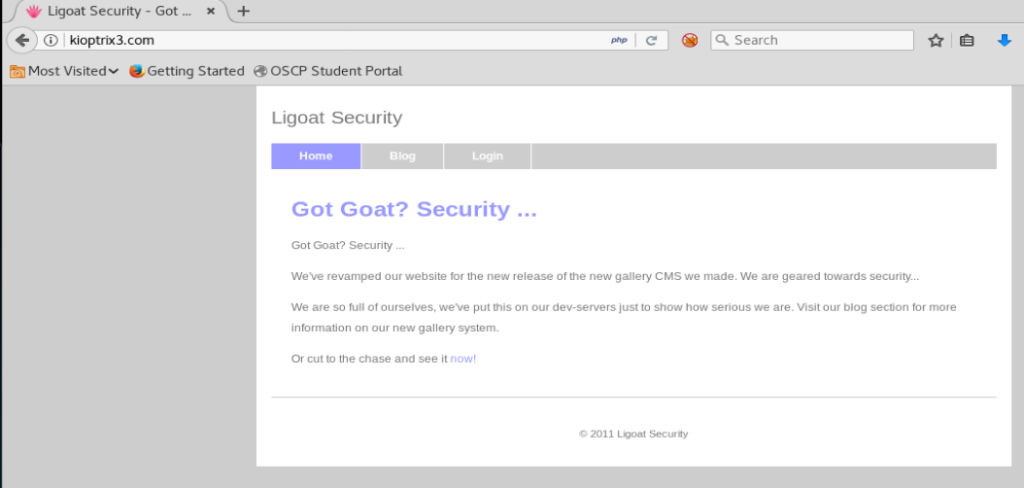
nMap
As always, we’ll start with a nMap scan. For now I’ll just do nmap -sV 192.168.174.143

Looks like early scan results show port 22 and 80 is open (the latter which we already knew).
Since we’re doing a HTTP scan initially, let’s use Nikto to get some more information: nikto -h 192.168.174.143

It looks like we’re running Apache 2.2.8 and PHP. So, let’s go back to our web browser and start clicking around a little bit just to see what kind of features are on the website.
So, if we click around on the website a little bit we come to the Blog, where there’s an interesting piece of information involving the gallery for the website:

We see it references the gallery, but it’s not a URL we can click on, so let’s navigate to it manually via the address bar.
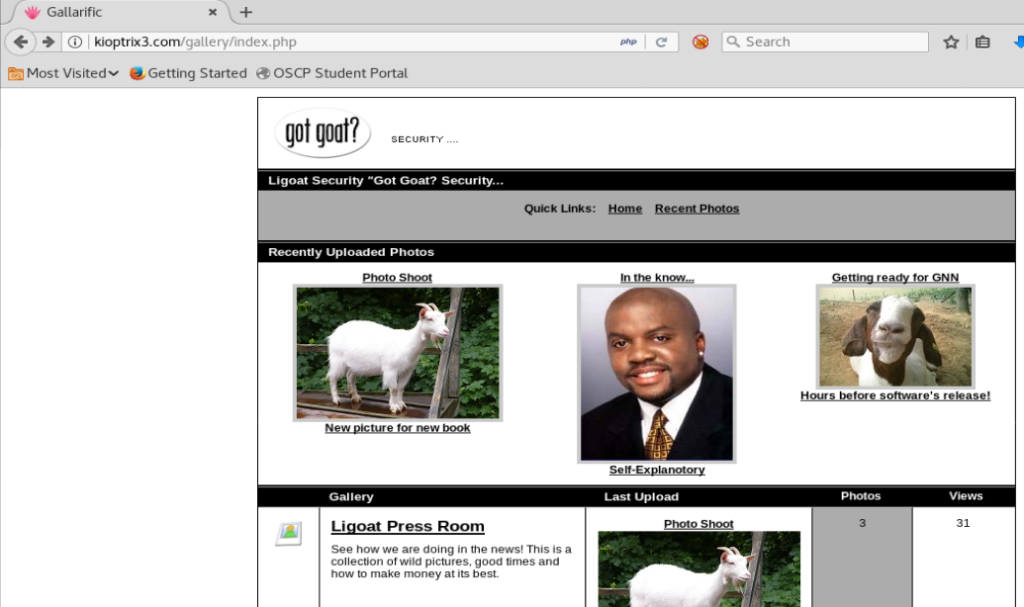
Once we get here, we can click around a bit. In this kind of situation we’re looking for a couple of things, most notable a URL that has characteristics we might be able to exploit.
After clicking around for a while, I got to the page I wanted. I got there by clicking on the Ligoat Press Room link and then Sorting Options


And when we do this we get a URL we might be able to play with:

What we’re looking for is that id=1 line in the URL, or something similar. So, let’s tweak the URL to include a ‘ after the id=1 and see what happens:

And we get a SQL error, which tells us this website is vulnerable to SQL injection. Cool! Let’s see if we can play with it a bit more
What we want to know is how many columns are in this database and which columns may be vulnerable. To do this, we can modify our statement above to ORDER the results by something. So let’s do this: id=1 order by 1 Note: I’m just updating the last part of the URL

And we get the same error. So let’s add — to the end of our URL and see if that works.
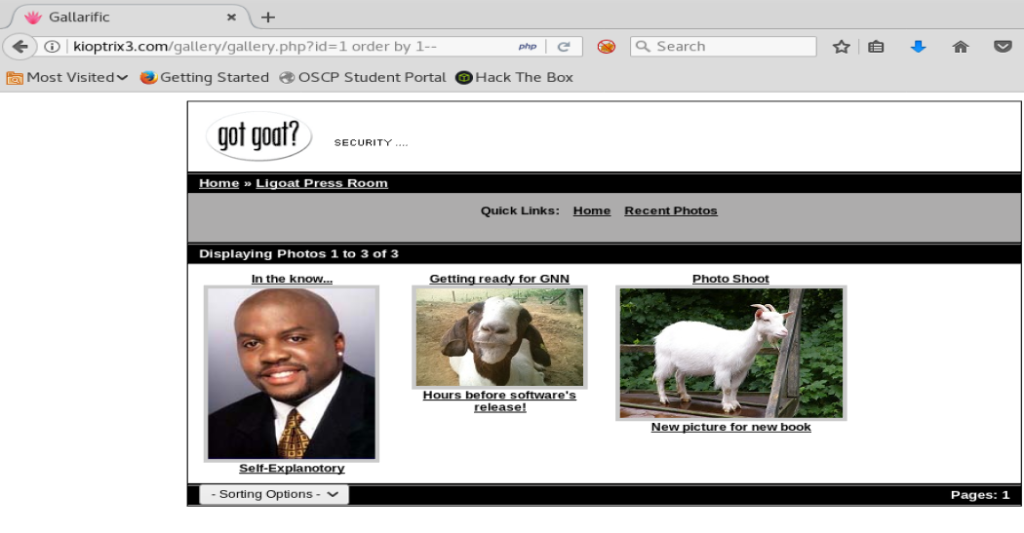
Cool cool. So we know our SQL is working. Now, let’s increase the number in the order by statement by one until we get an error that show there’s no more columns.

We can see here when we get to 7 we get an error. So there’s 6 columns in this database. Now, let’s get them to display.
We’ll use the SQL statement UNION SELECT to display our columns. So let’s update our URL with the following statement: id=1 union select 1,2,3,4,5,6

Ok, so we have something new displaying, but let’s see if we can tell which are vulnerable now.
To do this, we need to change the id value to negative, so -1 in this case.

Next, replace one of the column numbers with version()
Column 1 is probably going to be the ID, but we’ll try it anyway.

Well, we got something! Though it’s a pain in the ass to read. Let’s copy it and put it into a text editor.

Eh. It gives us a partial version: .51a-3ubuntu5.4 but for fun let’s just try column 2.
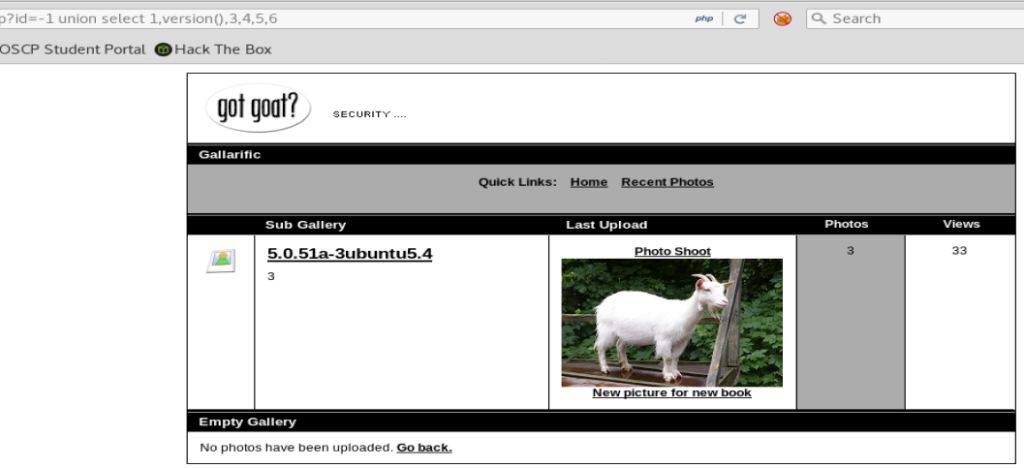
That looks better! We now know the version of SQL that we’re working with. Let’s see if we can also get the database name, too, by changing version() to database().
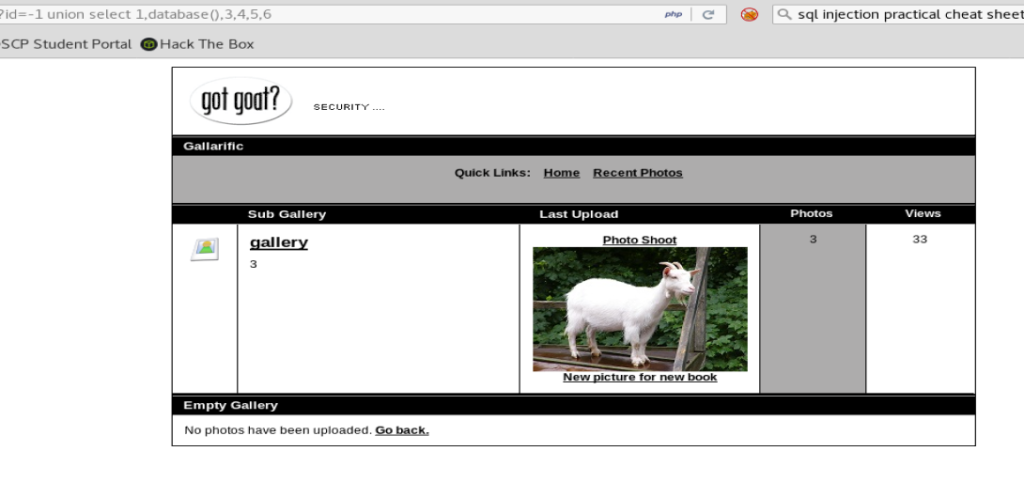
Looks like the name of our database is gallery. Cool cool!
The next step is getting the name of the tables in the database. We can use this brilliant cheat sheet to update our URL/queries to pull additional data out of the database: https://www.perspectiverisk.com/mysql-sql-injection-practical-cheat-sheet/
We’re going to tweak the Retrieve table names command with our information.
I started by opening up Leafpad and pasting my query on top, and then the new query below.

We’re gonna need to do the following:
- put a – in front of the query
- change NULL,concat(TABLE_NAME) to 1,concact(TABLE_NAME),3,4,5,6
- change ‘database1’ to database()
These three things were discovered by trial and error, but since our first query has the -1 we want this one to have -1. Also, the query we got from our website was built for a database with two columns, our query has six. And the reason for changing the database name should be obvious. The changes are circled in red below:

When we update our query we get a result that looks like this

And we got our table names. One looks really interesting: dev_accounts
So we’re gonna go back to our SQL cheat sheet and grab the Retrieve column names query, modify it like the database one, and execute it.
id=-1 UNION ALL SELECT 1,concat(TABLE_NAME),3,4,5,6 FROM information_schema.COLUMNS WHERE TABLE_NAME=dev_accounts–

And it fails. I’m not 100% sure why, but after some looking a solution presented itself.
I found a tool called hackbar and it’s an extension for Firefox that can help you update certain queries. So I installed that right quick. Make sure you show it in your toolbar, and check the box next to it.


Next, I highlighted the dev_accounts part, then from within Hackbar, clicked on MySQL, and then MySQL CHAR()

When you do that, you wind up with an updated SQL query:

Press the Execute button to load it in the browser, and you should see the column information for the dev_accounts table.

We’re getting there. Now let’s grab the command to Retrieve data from our SQL cheat sheet website and see if we can get some information.
id=-1 UNION ALL SELECT 1,concat(0x28,username,0x3a,password,0x29),3,4,5,6 FROM dev_accounts–
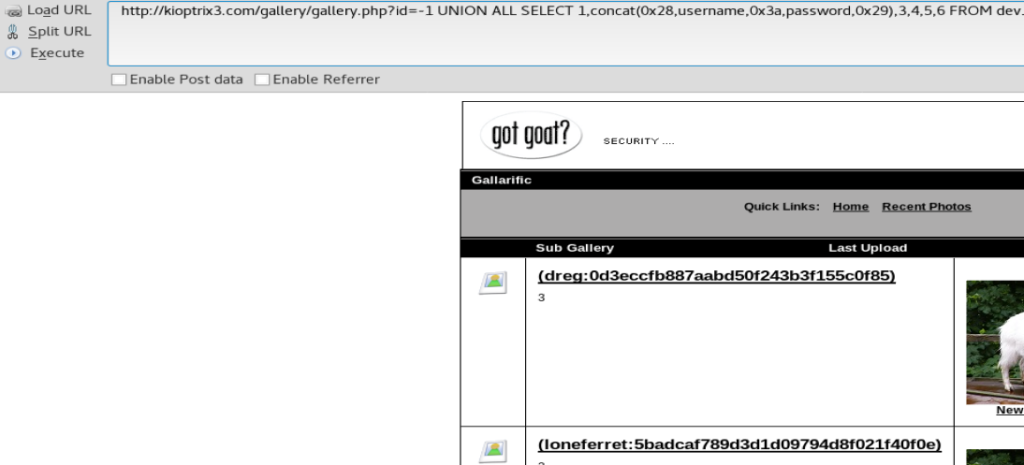
And we got some username and hashes!
Hashcat
Let’s store those two hashes into a .txt

Next, let’s use HashCat to try to figure out the passwords: hashcat -m 0 hashes.txt /usr/share/wordlists/rockyou.txt
- The -m 0 indicates an MD5 hash.
And then that failed on my VM. And I spent the next 2 hours troubleshooting it.

For the sake of time, and because I was trying to troubleshoot and see if my laptop’s specs we too outdated, I put Hashcat on my Windows 10 host VM. Don’t forget to put the rockyou.txt file on your Windows 10 box and point Hashcat to it. Once I did all that and ran Hashcat on my Win 10 box, I had the passwords pretty quickly.

SSH – Persistence and Privilege Escalation
The next step was to log into the box via SSH since we saw port 22 open. I used loneferret and starwars.

From the director we’re in there’s a file called CompanyPolicy.README so let’s take a look at it.

Ok, let’s see if we can find the sudo ht binary (program that can be run from Linux) using the whereis ht command. We’ll also run sudo -l to see what commands (if any) we can run as sudo.

So it looks like we can run the ht binary (program) as sudo. Let’s open it up with the command sudo ht

And go figure. Another error, but this time it looks like a hardware setting thing. No problem, a quick 5 minutes of Googling got us where we need to be. We type export TERM=xterm and then try to get the ht binary going again.


And we’re in! Let’s see if we can add our account to the /etc/sudoers list.
The interface is clunky as fuck, but I could get to the File option by pressing Alt + F and then using the arrow keys and Enter as needed. I changed the path to /etc/sudoers and pressed enter and got to this screen:

Once in the file, I used the arrow keys to move down to the line loneferret is on and added /bin/sh to the list of directories this user can access as sudo.

Next I hit Alt + F and Save to save the file and then Alt + F and Q to quit the program.
Finally, do sudo /bin/sh to get to the root account, and then navigate to the root directory.

Round 2 – LotusCMS
So, it also looks like LotusCMS might be vulnerable. A quick Google search revealed this: https://www.exploit-db.com/exploits/18565

But, that bad boy uses Metasploit, which we’re not gonna use. But let’s read about the exploit a little bit while on this page.

So it tells us we can embed some PHP code in the page= parameter on the URL. So if we click on the Home button we see there is a page= right there.

Let’s see if we can get some exploit code to work. First, we’ll go to our friend PenTest Monkey and check out their reverse shell cheat sheet: http://pentestmonkey.net/cheat-sheet/shells/reverse-shell-cheat-sheet

Let’s set up a Netcat listener on our Kali box and see if we can get a connection back.

And then I’m going to use Hackbar again to make my life a little easier. First, load the URL into HackBar.

Remove the word index, and then click on the Encoding button, and then URLencode.

Now, paste the PHP reverse shell code into the box, updating it with the IP address of your Kali machine and the port Netcat is listening in on.

Once it’s in your Hackbar, click on Execute.

And we get a failure.

And that failed.
After looking, I know it’s possible to poison the URL to get it to do what I want. But I’m going to have to research more.
LotusCMS Exploit
A little bit of Googling brought me to this webpage: https://github.com/Hood3dRob1n/LotusCMS-Exploit

So I downloaded the lotusRCE.sh script and executed it.

And then got a prompt on the correct way to point the script to the target…

So let’s add kioptrix3.com to our command.

And then put in the information for our Netcat listener on our Kali box.

And then on the next option I didn’t know what to select so I just picked 1, and got my shell.

Next, we’ll cat /etc/passwd and see if we can get a list of users.

There’s a couple hat look interesting. Let’s see if we can look at any of their directories. ls -la /home/loneferret

Let’s have a look at the CompanyPolicy.README file

And let’s see if there’s any configuration files in our web directory:

Cool, let’s cat the gconfig.php file.

Cool! For fun, I used ssh to try to log in with that root username and password, bu no luck. It must just work for the database.

No worries. But, we can navigate here and try to log in: http://kioptrix3.com/phpmyadmin/

Once you’re logged in, getting the hashes of the passwords for dreg and loneferret is trivial. I just went to Export after I loaded the Gallery database and had them displayed in a PDF.

Method 3 – SSH Brute Force
Rolling WAY BACK to the beginning, let’s pretend like we don’t know anything. Going back to the main kioptrix3.com website, if we click around the Blog we can see the username of someone.

For fun, let’s use Hydra and see if we can bruteforce it. But first, we need a decent password wordlist.
We’ll use Daniel Meissler’s, so bring up a terminal and do wget https://github.com/danielmiessler/SecLists/blob/master/Passwords/Common-Credentials/10-million-password-list-top-10000.txt
We’ll use this word list against SSH on our target box with the following command: hydra -e nsr -l loneferret -P 10-million-password-list-top-10000.txt 192.168.174.143 ssh -t 4

I truly appreciate this post. I’ve been looking everywhere for this! Thank goodness I found it on Bing. You have made my day! Thanks again
excellent issues altogether, you simply received a new reader. What may you recommend about your submit that you simply made some days ago? Any certain?
equilibrado de turbinas
Aparatos de ajuste: clave para el operación fluido y óptimo de las máquinas.
En el campo de la innovación actual, donde la efectividad y la estabilidad del dispositivo son de suma significancia, los sistemas de equilibrado cumplen un rol vital. Estos aparatos específicos están diseñados para balancear y estabilizar elementos dinámicas, ya sea en equipamiento productiva, vehículos de transporte o incluso en aparatos domésticos.
Para los técnicos en conservación de sistemas y los ingenieros, operar con aparatos de calibración es fundamental para garantizar el operación uniforme y fiable de cualquier dispositivo rotativo. Gracias a estas alternativas tecnológicas innovadoras, es posible reducir notablemente las vibraciones, el zumbido y la presión sobre los soportes, extendiendo la duración de componentes importantes.
Igualmente relevante es el función que desempeñan los sistemas de equilibrado en la asistencia al comprador. El asistencia especializado y el conservación constante usando estos sistemas facilitan dar soluciones de alta excelencia, incrementando la bienestar de los compradores.
Para los dueños de proyectos, la financiamiento en sistemas de balanceo y medidores puede ser importante para optimizar la rendimiento y desempeño de sus sistemas. Esto es particularmente importante para los inversores que administran pequeñas y pequeñas empresas, donde cada punto importa.
Por otro lado, los equipos de calibración tienen una extensa uso en el sector de la protección y el control de estándar. Permiten identificar eventuales errores, reduciendo arreglos costosas y perjuicios a los aparatos. Además, los información generados de estos sistemas pueden usarse para optimizar procedimientos y mejorar la visibilidad en motores de consulta.
Las áreas de implementación de los aparatos de calibración incluyen múltiples industrias, desde la fabricación de ciclos hasta el control ambiental. No afecta si se refiere de importantes elaboraciones manufactureras o pequeños espacios hogareños, los sistemas de calibración son indispensables para proteger un funcionamiento productivo y sin riesgo de paradas.
This website contains relevant knowledge about methods for becoming a IT infiltrator.
Facts are conveyed in a easily digestible manner.
The site teaches multiple methods for accessing restricted areas.
Furthermore, there are working models that display how to apply these competencies.
how to learn hacking
Whole material is frequently refreshed to stay current with the newest developments in computer security.
Distinct concentration is given to operational employment of the learned skills.
Note that every action should be used legally and through ethical means only.
This website contains practical guidance about instructions for transforming into a hacker.
Content is delivered in a precise and comprehensible manner.
You will learn diverse strategies for breaking through security.
Moreover, there are working models that manifest how to employ these expertise.
how to learn hacking
Full details is often renewed to be in sync with the contemporary changes in information security.
Particular focus is devoted to applied practice of the acquired knowledge.
Keep in mind that every action should be utilized ethically and according to proper guidelines only.
This website contains necessary info about steps to becoming a security expert.
Details are given in a straightforward and coherent manner.
The site teaches various techniques for breaking through security.
Plus, there are hands-on demonstrations that display how to apply these capabilities.
how to become a hacker
Full details is persistently upgraded to correspond to the modern innovations in network protection.
Extra care is devoted to everyday implementation of the absorbed know-how.
Bear in mind that every procedure should be carried out conscientiously and with moral considerations only.
Here, discover interactive video sessions.
Whether you’re looking for friendly chats career-focused talks, the site offers a solution tailored to you.
Live communication module is designed to connect people across different regions.
With high-quality video and clear audio, any discussion becomes engaging.
Engage with open chat spaces or start private chats, based on your preferences.
https://rt.erovideochat.pw/
What’s required is a stable internet connection and a device start connecting.
Within this platform, discover interactive video sessions.
Interested in casual conversations or professional networking, you’ll find options for any preference.
The video chat feature developed to connect people across different regions.
Featuring HD streams and clear audio, any discussion feels natural.
Participate in public rooms initiate one-on-one conversations, according to what suits you best.
https://rt.mdksex.com/couples
The only thing needed is a stable internet connection plus any compatible tool to get started.
This website, you can discover a great variety of slot machines from top providers.
Visitors can try out retro-style games as well as modern video slots with stunning graphics and bonus rounds.
If you’re just starting out or a seasoned gamer, there’s a game that fits your style.
play bonanza
Each title are instantly accessible round the clock and optimized for desktop computers and smartphones alike.
You don’t need to install anything, so you can jump into the action right away.
Site navigation is easy to use, making it simple to browse the collection.
Join the fun, and enjoy the thrill of casino games!
This website, you can access lots of casino slots from famous studios.
Players can experience classic slots as well as feature-packed games with high-quality visuals and bonus rounds.
Even if you’re new or a seasoned gamer, there’s something for everyone.
no depisit bonus
The games are available anytime and compatible with PCs and tablets alike.
All games run in your browser, so you can get started without hassle.
The interface is easy to use, making it simple to browse the collection.
Register now, and discover the world of online slots!
кликните сюда https://kra-34c.cc
This website, you can access lots of slot machines from top providers.
Users can experience retro-style games as well as new-generation slots with stunning graphics and interactive gameplay.
If you’re just starting out or an experienced player, there’s always a slot to match your mood.
money casino
Each title are available 24/7 and designed for PCs and mobile devices alike.
All games run in your browser, so you can jump into the action right away.
Platform layout is easy to use, making it simple to explore new games.
Register now, and dive into the thrill of casino games!
On this platform, you can find a wide selection of casino slots from top providers.
Users can enjoy retro-style games as well as feature-packed games with high-quality visuals and exciting features.
Even if you’re new or a casino enthusiast, there’s always a slot to match your mood.
slot casino
The games are ready to play 24/7 and compatible with desktop computers and tablets alike.
You don’t need to install anything, so you can get started without hassle.
Platform layout is intuitive, making it simple to find your favorite slot.
Sign up today, and enjoy the world of online slots!
Here, you can find a great variety of casino slots from famous studios.
Users can try out retro-style games as well as new-generation slots with stunning graphics and exciting features.
Even if you’re new or a seasoned gamer, there’s always a slot to match your mood.
play games
Each title are available anytime and optimized for desktop computers and mobile devices alike.
You don’t need to install anything, so you can get started without hassle.
Site navigation is intuitive, making it convenient to find your favorite slot.
Sign up today, and dive into the world of online slots!
This website, you can discover a great variety of slot machines from famous studios.
Players can experience retro-style games as well as modern video slots with stunning graphics and interactive gameplay.
If you’re just starting out or a casino enthusiast, there’s something for everyone.
no depisit bonus
All slot machines are instantly accessible anytime and optimized for desktop computers and tablets alike.
No download is required, so you can get started without hassle.
Platform layout is easy to use, making it quick to explore new games.
Register now, and discover the excitement of spinning reels!
The intersection of estate planning and Medicaid qualification requires specialized expertise. Knowledgeable Medicaid planners provide comprehensive guidance.
подробнее казино онлайн без регистрации
本网站 提供 海量的 成人资源,满足 成年访客 的 需求。
无论您喜欢 什么样的 的 内容,这里都 应有尽有。
所有 材料 都经过 精心筛选,确保 高品质 的 视觉享受。
A片
我们支持 多种设备 访问,包括 平板,随时随地 尽情观看。
加入我们,探索 激情时刻 的 两性空间。
本站 提供 多样的 成人资源,满足 不同用户 的 喜好。
无论您喜欢 哪一类 的 内容,这里都 种类齐全。
所有 内容 都经过 精心筛选,确保 高清晰 的 视觉享受。
成人网站
我们支持 各种终端 访问,包括 电脑,随时随地 畅享内容。
加入我们,探索 无限精彩 的 成人世界。
Here, explore a variety of online casinos.
Whether you’re looking for well-known titles new slot machines, there’s something for any taste.
Every casino included checked thoroughly to ensure security, enabling gamers to bet securely.
gambling
Additionally, the platform unique promotions plus incentives for new players as well as regulars.
Thanks to user-friendly browsing, locating a preferred platform is quick and effortless, making it convenient.
Keep informed regarding new entries by visiting frequently, because updated platforms are added regularly.
这个网站 提供 丰富的 成人材料,满足 各类人群 的 需求。
无论您喜欢 哪种类型 的 内容,这里都 种类齐全。
所有 资源 都经过 严格审核,确保 高质量 的 观看体验。
黄色书刊
我们支持 各种终端 访问,包括 电脑,随时随地 畅享内容。
加入我们,探索 激情时刻 的 两性空间。
On this site, find a variety virtual gambling platforms.
Searching for classic games or modern slots, there’s something for every player.
All featured casinos checked thoroughly for trustworthiness, so you can play peace of mind.
pin-up
Moreover, the platform offers exclusive bonuses plus incentives for new players as well as regulars.
Due to simple access, locating a preferred platform takes just moments, enhancing your experience.
Stay updated about the latest additions with frequent visits, because updated platforms appear consistently.
Мужики, если везде отказы по займам — не тяните, заходите на https://mfo-zaim.com/dengi-v-dolg-ot-mfo-bez-proverki-ki/ . Мне помог Виктор Гардиенов. Чётко объяснил, в чём ошибка, и как повысить шансы. Сейчас беру без звонков и проверок, как часы работает.
这个网站 提供 丰富的 成人材料,满足 各类人群 的 需求。
无论您喜欢 什么样的 的 影片,这里都 应有尽有。
所有 材料 都经过 专业整理,确保 高清晰 的 浏览感受。
拜物教
我们支持 多种设备 访问,包括 平板,随时随地 尽情观看。
加入我们,探索 无限精彩 的 两性空间。
Within this platform, you can discover an extensive selection internet-based casino sites.
Interested in traditional options or modern slots, there’s a choice to suit all preferences.
Every casino included are verified for safety, allowing users to gamble with confidence.
1xbet
Moreover, the platform offers exclusive bonuses and deals to welcome beginners including long-term users.
With easy navigation, locating a preferred platform is quick and effortless, enhancing your experience.
Be in the know on recent updates by visiting frequently, because updated platforms appear consistently.
Here, you can discover an extensive selection internet-based casino sites.
Whether you’re looking for well-known titles new slot machines, there’s something for any taste.
The listed platforms are verified to ensure security, so you can play peace of mind.
play slots
Additionally, the platform offers exclusive bonuses along with offers for new players including long-term users.
Due to simple access, locating a preferred platform takes just moments, making it convenient.
Keep informed regarding new entries with frequent visits, as fresh options appear consistently.
On this site, you can discover a wide range of online casinos.
Interested in well-known titles or modern slots, there’s a choice for every player.
The listed platforms are verified to ensure security, enabling gamers to bet with confidence.
pin-up
Additionally, the site unique promotions along with offers for new players including long-term users.
Thanks to user-friendly browsing, discovering a suitable site is quick and effortless, saving you time.
Stay updated about the latest additions by visiting frequently, because updated platforms are added regularly.
В этом ресурсе вы можете получить доступ к боту “Глаз Бога” , который может проанализировать всю информацию о любом человеке из публичных данных.
Этот мощный инструмент осуществляет поиск по номеру телефона и показывает информацию из государственных реестров .
С его помощью можно проверить личность через Telegram-бот , используя фотографию в качестве ключевого параметра.
пробив по фото
Система “Глаз Бога” автоматически анализирует информацию из открытых баз , формируя исчерпывающий результат.
Подписчики бота получают пробный доступ для проверки эффективности.
Платформа постоянно развивается, сохраняя скорость обработки в соответствии с законодательством РФ.
click this link now jaxx bitcoin wallet
донат в фортнайт в россии – v buck fortnite купить, купить в баксы